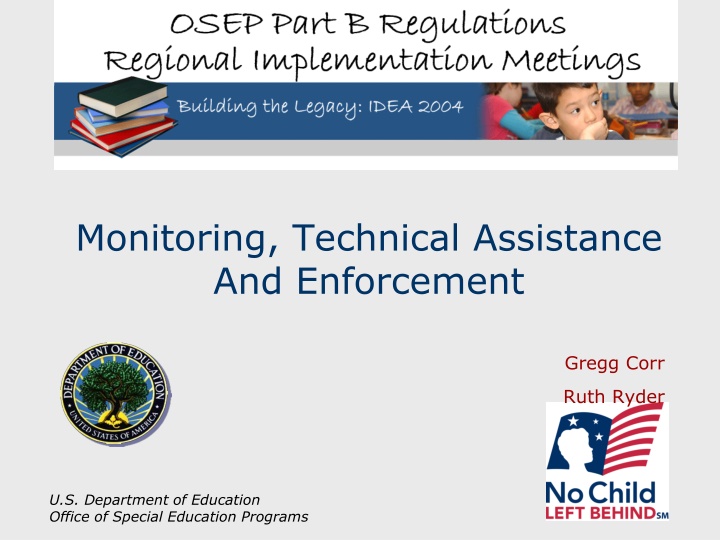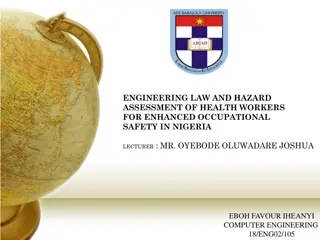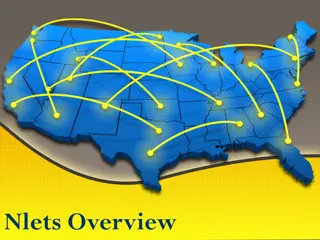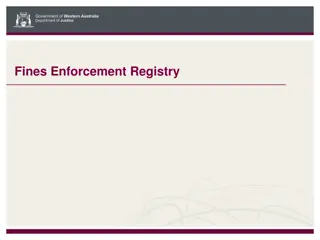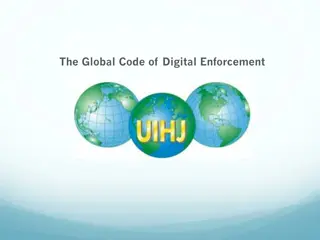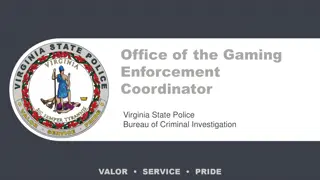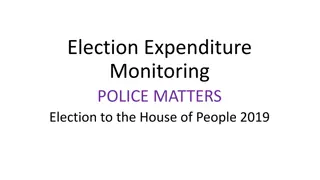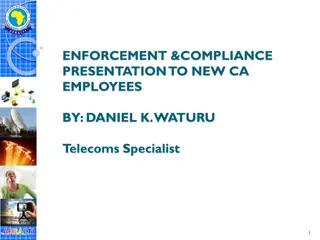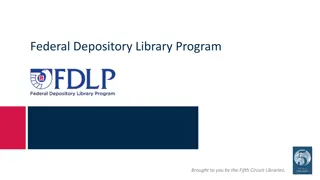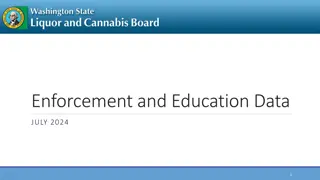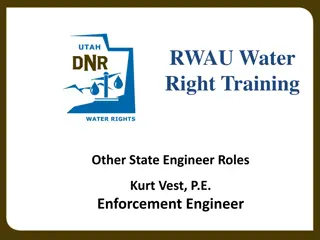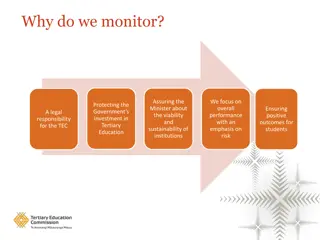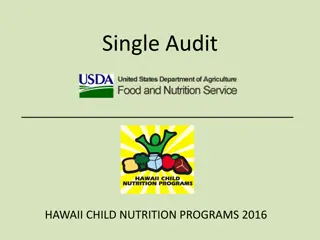Federal Responsibilities for Monitoring and Enforcement in Education Programs
This content discusses the federal and state responsibilities for monitoring, technical assistance, and enforcement in education programs under the Individuals with Disabilities Education Act (IDEA) 2004. It covers key requirements, state performance plans, monitoring priority areas such as free appropriate public education (FAPE) and disproportionate representation in special education, and the importance of improving educational outcomes through oversight and enforcement.
Download Presentation

Please find below an Image/Link to download the presentation.
The content on the website is provided AS IS for your information and personal use only. It may not be sold, licensed, or shared on other websites without obtaining consent from the author.If you encounter any issues during the download, it is possible that the publisher has removed the file from their server.
You are allowed to download the files provided on this website for personal or commercial use, subject to the condition that they are used lawfully. All files are the property of their respective owners.
The content on the website is provided AS IS for your information and personal use only. It may not be sold, licensed, or shared on other websites without obtaining consent from the author.
E N D
Presentation Transcript
Monitoring, Technical Assistance And Enforcement Gregg Corr Ruth Ryder U.S. Department of Education Office of Special Education Programs
Introduction Federal and State Responsibilities for Monitoring, Technical Assistance and Enforcement Key requirements set forth at: Section 616 of IDEA 2004 34 CFR 300.600 300.609 U.S. Department of Education Office of Special Education Programs Building the Legacy 2004 2
Monitoring and Enforcement Primary focus of federal and state monitoring activities must be on: Improving education results and functional outcomes Ensuring that public agencies meet program requirements, particularly those most closely related to improving educational results U.S. Department of Education Office of Special Education Programs Building the Legacy 2004 3
Federal and State Responsibilities Monitoring State Performance Plan (SPP)/ Annual Performance Report (APR) Reporting Determinations Monitoring On-going oversight U.S. Department of Education Office of Special Education Programs Building the Legacy 2004 4
State Performance Plan As part of the SPP, each state must establish measurable and rigorous targets for the indicators established by the Secretary under the priority areas U.S. Department of Education Office of Special Education Programs Building the Legacy 2004 5
Monitoring Priority Areas Provision of a free appropriate public education (FAPE) in the least restrictive environment (LRE) State exercise of general supervision, including child find, effective monitoring, the use of resolution meetings, mediation, and a system of transition services as defined in 300.43 and in 20 U.S.C. 1437(a)(9) and U.S. Department of Education Office of Special Education Programs Building the Legacy 2004 6
Monitoring Priority Areas Disproportionate representation of racial and ethnic groups in special education and related services, to the extent the representation is the result of inappropriate identification U.S. Department of Education Office of Special Education Programs Building the Legacy 2004 7
State Performance Plan Each state must: Submit its performance plan to the Secretary for approval in accordance with the process described in section 616(c) Review its performance plan at least once every six years, and submit any amendments to the Secretary U.S. Department of Education Office of Special Education Programs Building the Legacy 2004 8
Performance Measurement Each state must use quantifiable indicators and such qualitative indicators as are needed to adequately measure performance in the priority areas, and the indicators established by the Secretary for the SPPs U.S. Department of Education Office of Special Education Programs Building the Legacy 2004 9
Annual Performance Report Each state must collect valid and reliable information to report annually to the Secretary on the indicators established by the Secretary for the SPPs If a state collects data on an indicator through state monitoring or sampling, data must be collected for each local educational agency (LEA) at least once during the period of the SPP U.S. Department of Education Office of Special Education Programs Building the Legacy 2004 10
When does six-year review begin? States must annually report on performance for the years 2005-2006 through 2010-2011 U.S. Department of Education Office of Special Education Programs Building the Legacy 2004 11
SPP years and corresponding APR due dates 1. 2005-06 due February 2007 2. 2006-07 due February 2008 3. 2007-08 due February 2009 4. 2008-09 due February 2010 5. 2009-10 due February 2011 6. 2010-11 due February 2012 U.S. Department of Education Office of Special Education Programs Building the Legacy 2004 12
How should states involve their stakeholders at this time? Stakeholder involvement in targets for new SPP indicators Recommended involvement in developing or revising improvement activities Recommended involvement in distributing, discussing SPP/APR, especially reporting on local programs U.S. Department of Education Office of Special Education Programs Building the Legacy 2004 13
Reporting to the Secretary Annually report to the Secretary and the public on the state s progress and/or slippage in meeting the measurable and rigorous targets found in the SPP; If the state collects data using sampling or state monitoring, include the most recently available data on each LEA and the date obtained U.S. Department of Education Office of Special Education Programs Building the Legacy 2004 14
Public Reporting Make the state s performance plan available through public means, including by posting on the state educational agency s (SEA s) website, distribution to the media, and distribution through public agencies U.S. Department of Education Office of Special Education Programs Building the Legacy 2004 15
Analyzing LEA Performance Each state must use the targets in its SPP to analyze the performance of each LEA U.S. Department of Education Office of Special Education Programs Building the Legacy 2004 16
When must states begin reporting on LEA Performance? Spring 2007 State must report to public on status of LEAs against 2005- 06 SPP targets U.S. Department of Education Office of Special Education Programs Building the Legacy 2004 17
Reporting to the Public on LEA Performance Public reporting must ensure broad dissemination such as posting on the agency s website The report must be accessible to individuals with disabilities Public report must clearly reflect the SPP indicators Report must be understandable to the public U.S. Department of Education Office of Special Education Programs Building the Legacy 2004 18
Are states required to report LEA performance on all indicators? States are not required to report LEA data for new indicators for which they have not yet set targets in their SPPs States are not required to report LEA data on indicators 15 through 20 U.S. Department of Education Office of Special Education Programs Building the Legacy 2004 19
New Indicators 4B Suspension/Expulsion disaggregated by race/ethnicity 7 Preschool outcomes 8 Parent involvement 9 Disproportionality (special ed. and related services) 10 Disproportionality specific disability category) 11 Child Find 13 Post-school transition 14 Post-school outcomes U.S. Department of Education Office of Special Education Programs Building the Legacy 2004 20
When N is too small When an LEA s N size is too small to report by LEA, it is permissible to report intermediate unit information U.S. Department of Education Office of Special Education Programs Building the Legacy 2004 21
Specific result vs. Pass/Fail The LEA report must include a specific result (e.g. percent scores) U.S. Department of Education Office of Special Education Programs Building the Legacy 2004 22
Secretarys Determinations Secretary annually reviews the APR and, based on the information provided in the report, information obtained through monitoring visits, and any other public information available, the Secretary determines if the state: U.S. Department of Education Office of Special Education Programs Building the Legacy 2004 23
Secretarys Determinations Meets requirements Needs assistance Needs intervention Needs substantial intervention U.S. Department of Education Office of Special Education Programs Building the Legacy 2004 24
What will OSEP consider in making the Determinations? Department will consider all information available at the time of the determinations including: History, nature and length of time of any reported noncompliance Evidence of correction, including progress toward full compliance Information regarding valid and reliable data U.S. Department of Education Office of Special Education Programs Building the Legacy 2004 25
Determination Considerations Other information: Special conditions Compliance agreements Audit findings OSEP s verification or focused monitoring findings U.S. Department of Education Office of Special Education Programs Building the Legacy 2004 26
Separate Determinations for Each Indicator? No OSEP will make one determination for each State U.S. Department of Education Office of Special Education Programs Building the Legacy 2004 27
What factors will OSEP consider for meets requirements? State demonstrates substantial compliance on all compliance indicators Demonstrate through quantitative or qualitative data that state timely corrects for not new indicators Have improvement activities to timely correct for new indicators Valid and reliable data for all indicators State timely corrects noncompliance U.S. Department of Education Office of Special Education Programs Building the Legacy 2004 28
What factors will OSEP consider for needs assistance? State does not demonstrate substantial compliance on all compliance indicators One or more indicators do not include valid and reliable data State does not demonstrate that it timely corrects any noncompliance After 2 consecutive years the Department will take enforcement action U.S. Department of Education Office of Special Education Programs Building the Legacy 2004 29
Needs Assistance Enforcement Actions The regulations establish enforcement actions that the Secretary shall take with regard to determinations on state performance U.S. Department of Education Office of Special Education Programs Building the Legacy 2004 30
Needs Assistance Enforcement Actions Advises the state of available technical assistance that may help the state address the areas in which it needs assistance Directs the use of state-level funds under section 611(e) of the Act on the area or areas in which the state needs assistance Identifies the state as a high-risk grantee and imposes special conditions on the state's grant under Part B of the Act U.S. Department of Education Office of Special Education Programs Building the Legacy 2004 31
What factors will OSEP consider for needs intervention? State does not demonstrate substantial compliance on all compliance indicators AND has not made progress in correcting noncompliance One or more indicators do not include valid and reliable data AND the state has not made progress in correcting previously identified data problems U.S. Department of Education Office of Special Education Programs Building the Legacy 2004 32
FactorsNeeds Intervention State does not demonstrate that it timely corrects any noncompliance AND has not made progress in correcting that noncompliance After 3 consecutive years the Department will take enforcement action U.S. Department of Education Office of Special Education Programs Building the Legacy 2004 33
Needs Intervention Enforcement actions The Secretary may take any of the actions available under Needs Assistance U.S. Department of Education Office of Special Education Programs Building the Legacy 2004 34
Needs Intervention Enforcement Actions The Secretary also takes one or more of the following actions: Requires the state to prepare a corrective action plan or improvement plan if the Secretary determines that the state should be able to correct the problem within one year Requires the state to enter into a compliance agreement (GEPA), if the Secretary has reason to believe that the state cannot correct the problem within one year U.S. Department of Education Office of Special Education Programs Building the Legacy 2004 35
Needs Intervention Enforcement Actions For each year of the determination, withholds not less than 20 percent and not more than 50 percent of the state's funds under section 611(e) of the Act [state administration funds], until the Secretary determines the state has sufficiently addressed the areas in which the state needs intervention Seeks to recover funds under section 452 of GEPA U.S. Department of Education Office of Special Education Programs Building the Legacy 2004 36
Needs Intervention Enforcement Actions Withholds, in whole or in part, any further payments to the state under Part B of the Act AND/OR Refers the matter for appropriate enforcement action, which may include referral to the Department of Justice U.S. Department of Education Office of Special Education Programs Building the Legacy 2004 37
What factors will OSEP consider for needs substantial intervention? Factors to be considered are: Failure to substantially comply that significantly affects core requirements of the program; and/or State has informed the Department that it is unwilling to comply Department can take enforcement action at any time U.S. Department of Education Office of Special Education Programs Building the Legacy 2004 38
Needs Substantial Intervention Enforcement Actions Any time that the Secretary determines that a state needs substantial intervention or that there is a substantial failure to comply with any condition of an SEA's or LEA's eligibility under Part B, the Secretary takes one or more of the following actions: U.S. Department of Education Office of Special Education Programs Building the Legacy 2004 39
Needs Substantial Intervention Enforcement Actions Recovers funds under section 452 of GEPA Withholds, in whole or in part, any further payments to the state under Part B of the Act Refers the case to the Department s Office of the Inspector General Refers the matter for appropriate enforcement action, which may include referral to the Department of Justice U.S. Department of Education Office of Special Education Programs Building the Legacy 2004 40
Other Enforcement Mechanisms Nothing in this subpart shall be construed to restrict the Secretary from utilizing any authority under the GEPA to monitor and enforce the requirements of the Act, including the imposition of special conditions under 34 CFR 80.12 U.S. Department of Education Office of Special Education Programs Building the Legacy 2004 41
Timing of Enforcements Actions Are enforcement actions sequential? Must OSEP wait two (needs assistance) or three (needs intervention) years before taking enforcement action? U.S. Department of Education Office of Special Education Programs Building the Legacy 2004 42
Notice and Opportunity for Hearing Department provides notice of action pending based on a determination State has opportunity to meet with Assistant Secretary U.S. Department of Education Office of Special Education Programs Building the Legacy 2004 43
Public Notice When a state has been determined to need assistance, need intervention, or need substantial intervention, the state must notify the public of the pendency of an enforcement action pursuant to 34 CFR 300.604 U.S. Department of Education Office of Special Education Programs Building the Legacy 2004 44
Are States required to make Determinations? States are required to make Determinations under 616(d) States will make the Determinations Spring 2007 based on LEA program performance on the targets in the SPP U.S. Department of Education Office of Special Education Programs Building the Legacy 2004 45
Reporting LEA Determinations Will the LEA determinations be reported in the state s APR? How would reporting LEA determinations change the requirements under the SPP? U.S. Department of Education Office of Special Education Programs Building the Legacy 2004 46
What do states consider in making their Determinations? MUST consider Performance on compliance indicators Valid, reliable, timely data Audit findings Uncorrected noncompliance from other sources COULD consider Performance on outcomes indicators Others? U.S. Department of Education Office of Special Education Programs Building the Legacy 2004 47
What if LEA disagrees with determination? Not a Part B requirement, but SEA may want to consider providing LEAs with an opportunity for a hearing U.S. Department of Education Office of Special Education Programs Building the Legacy 2004 48
State Enforcement Enforce in accordance with 34 CFR 300.604 (a)(1) Advise LEA of available TA (a)(3) Identify LEA as high risk and impose special conditions (b)(2)(i) Require LEA to prepare corrective action plan (b)(2)(v) and (c)(2) Withhold in whole or in part U.S. Department of Education Office of Special Education Programs Building the Legacy 2004 49
State Enforcement Needs assistance Advises LEA of available sources of TA, including Provision of advice by experts Professional development, instructional strategies and methods Designating distinguished educators Collaboration with Institutions of Higher Education (IHEs), national technical assistance (TA) centers, and private TA providers U.S. Department of Education Office of Special Education Programs Building the Legacy 2004 50
